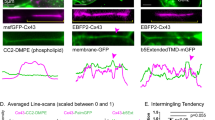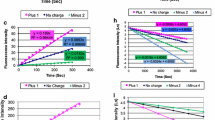Abstract
Pannexins (Panx) are proteins with a similar membrane topology to connexins, the integral membrane protein of gap junctions. Panx1 channels are generally of major importance in a large number of system and cellular processes and their function has been thoroughly characterized. In contrast, little is known about channel structure and subcellular distribution. We therefore determine the subcellular localization of Panx1 channels in cultured cells and aim at the identification of channel morphology in vitro. Using freeze-fracture replica immunolabeling on EYFP-Panx1-overexpressing HEK 293 cells, large particles were identified in plasma membranes, which were immunogold-labeled using either GFP or Panx1 antibodies. There was no labeling or particles in the nuclear membranes of these cells, pointing to plasma membrane localization of Panx1-EYFP channels. The assembly of particles was irregular, this being in contrast to the regular pattern of gap junctions. The fact that no counterparts were identified on apposing cells, which would have been indicative of intercellular signaling, supported the idea of Panx1 channels within one membrane. Control cells (transfected with EYFP only, non-transfected) were devoid of both particles and immunogold labeling. Altogether, this study provides the first demonstration of Panx1 channel morphology and assembly in intact cells. The identification of Panx1 channels as large particles within the plasma membrane provides the knowledge required to enable recognition of Panx1 channels in tissues in future studies. Thus, these results open up new avenues for the detailed analysis of the subcellular localization of Panx1 and of its nearest neighbors such as purinergic receptors in vivo.







Similar content being viewed by others
Abbreviations
- aa:
-
Amino acids
- ATP:
-
Adenosine triphosphate
- bp:
-
Base pairs
- CPC:
-
Cryopreparation chamber
- DCE:
-
Dichloroethane
- E:
-
Extraplasmic
- ECL:
-
Electrochemiluminescence
- EtBr:
-
Ethidium bromide
- EYFP:
-
Enhanced yellow fluorescent protein
- FCS:
-
Fetal calf serum
- FRIL:
-
Freeze-fracture replica immunolabeling
- GFP:
-
Green fluorescent protein
- HEK:
-
Human embryonic kidney
- IMP:
-
Intramembrane particle
- LBB:
-
Labeling blocking buffer
- LSM:
-
Laser scanning microscopy
- P:
-
Protoplasmic
- Panx1:
-
Pannexin 1
- SDS:
-
Sodium dodecylsulfate
- SEM:
-
Standard error of the mean
- SD:
-
Standard deviation
- SPB:
-
Soerensen’s phosphate buffer
- SNR:
-
Signal-to-noise ratio
- TEM:
-
Transmission electron microscope
References
Ambrosi C, Gassmann O, Pranskevich JN, Boassa D, Smock A, Wang J, Dahl G, Steinem C, Sosinsky GE (2010) Pannexin1 and pannexin2 channels show quaternary similarities to connexons and different oligomerization numbers from each other. J Biol Chem 285:24420–24431
Bao L, Locovei S, Dahl G (2004) Pannexin membrane channels are mechanosensitive conduits for ATP. FEBS Lett 572:65–68
Baranova A, Ivanov D, Petrash N, Pestova A, Skoblov M, Kelmanson I, Shagin D, Nazarenko S, Geraymovych E, Litvin O, Tiunova A, Born TL, Usman N, Staroverov D, Lukyanov S, Panchin Y (2004) The mammalian pannexin family is homologous to the invertebrate innexin gap junction proteins. Genomics 83:706–716
Boassa D, Ambrosi C, Qiu F, Dahl G, Gaietta G, Sosinsky G (2007) Pannexin1 channels contain a glycosylation site that targets the hexamer to the plasma membrane. J Biol Chem 282:31733–31743
Boassa D, Qiu F, Dahl G, Sosinsky G (2008) Trafficking dynamics of glycosylated pannexin 1 proteins. Cell Commun Adhes 15:119–132
Bond SR, Naus CC (2014) The pannexins: past and present. Front Physiol 5:58
Branton D, Bullivant S, Gilula NB, Karnovsky MJ, Moor H, Muhlethaler K, Northcote DH, Packer L, Satir B, Satir P, Speth V, Staehlin LA, Steere RL, Weinstein RS (1975) Freeze-etching nomenclature. Science 190:54–56
Bruzzone R, Hormuzdi SG, Barbe MT, Herb A, Monyer H (2003) Pannexins, a family of gap junction proteins expressed in brain. Proc Natl Acad Sci U S A 100:13644–13649
Cone AC, Ambrosi C, Scemes E, Martone ME, Sosinsky GE (2013) A comparative antibody analysis of pannexin1 expression in four rat brain regions reveals varying subcellular localizations. Front Pharmacol 4:6
Dahl G, Locovei S (2006) Pannexin: to gap or not to gap, is that a question? IUBMB Life 58:409–419
Falk MM, Lauf U (2001) High resolution, fluorescence deconvolution microscopy and tagging with the autofluorescent tracers CFP, GFP, and YFP to study the structural composition of gap junctions in living cells. Microsc Res Tech 52:251–262
Fujimoto K (1995) Freeze-fracture replica electron microscopy combined with SDS digestion for cytochemical labeling of integral membrane proteins. Application to the immunogold labeling of intercellular junctional complexes. J Cell Sci 108(Pt 11):3443–3449
Fujimoto K (1997) SDS-digested freeze-fracture replica labeling electron microscopy to study the two-dimensional distribution of integral membrane proteins and phospholipids in biomembranes: practical procedure, interpretation and application. Histochem Cell Biol 107:87–96
Furman CS, Gorelick-Feldman DA, Davidson KG, Yasumura T, Neely JD, Agre P, Rash JE (2003) Aquaporin-4 square array assembly: opposing actions of M1 and M23 isoforms. Proc Natl Acad Sci U S A 100:13609–13614
Gruijters WT, Kistler J, Bullivant S, Goodenough DA (1987) Immunolocalization of MP70 in lens fiber 16-17-nm intercellular junctions. J Cell Biol 104:565–572
Hulser DF, Rehkopf B, Traub O (1997) Dispersed and aggregated gap junction channels identified by immunogold labeling of freeze-fractured membranes. Exp Cell Res 233:240–251
Iglesias R, Dahl G, Qiu F, Spray DC, Scemes E (2009) Pannexin 1: the molecular substrate of astrocyte "hemichannels". J Neurosci 29:7092–7097
Kamasawa N, Furman CS, Davidson KG, Sampson JA, Magnie AR, Gebhardt BR, Kamasawa M, Yasumura T, Zumbrunnen JR, Pickard GE, Nagy JI, Rash JE (2006) Abundance and ultrastructural diversity of neuronal gap junctions in the OFF and ON sublaminae of the inner plexiform layer of rat and mouse retina. Neuroscience 142:1093–1117
Kurtenbach S, Prochnow N, Klooster J, Zoidl C, Dermietzel R, Kamermans M, Zoidl G (2013) Pannexin1 channel proteins in the zebrafish retina have shared and unique properties. PLoS ONE 8:e77722
Li X, Lynn BD, Olson C, Meier C, Davidson KG, Yasumura T, Rash JE, Nagy JI (2002) Connexin29 expression, immunocytochemistry and freeze-fracture replica immunogold labelling (FRIL) in sciatic nerve. Eur J Neurosci 16:795–806
Locovei S, Bao L, Dahl G (2006a) Pannexin 1 in erythrocytes: function without a gap. Proc Natl Acad Sci U S A 103:7655–7659
Locovei S, Wang J, Dahl G (2006b) Activation of pannexin 1 channels by ATP through P2Y receptors and by cytoplasmic calcium. FEBS Lett 580:239–244
Nagy JI, Dudek FE, Rash JE (2004) Update on connexins and gap junctions in neurons and glia in the mammalian nervous system. Brain Res Brain Res Rev 47:191–215
Pelegrin P, Surprenant A (2006) Pannexin-1 mediates large pore formation and interleukin-1beta release by the ATP-gated P2X7 receptor. EMBO J 25:5071–5082
Penuela S, Bhalla R, Gong XQ, Cowan KN, Celetti SJ, Cowan BJ, Bai D, Shao Q, Laird DW (2007) Pannexin 1 and pannexin 3 are glycoproteins that exhibit many distinct characteristics from the connexin family of gap junction proteins. J Cell Sci 120:3772–3783
Pereda A, O'Brien J, Nagy JI, Bukauskas F, Davidson KG, Kamasawa N, Yasumura T, Rash JE (2003) Connexin35 mediates electrical transmission at mixed synapses on Mauthner cells. J Neurosci 23:7489–7503
Proikas-Cezanne T, Robenek H (2011) Freeze-fracture replica immunolabelling reveals human WIPI-1 and WIPI-2 as membrane proteins of autophagosomes. J Cell Mol Med 15:2007–2010
Rash JE, Yasumura T (1999) Direct immunogold labeling of connexins and aquaporin-4 in freeze-fracture replicas of liver, brain, and spinal cord: factors limiting quantitative analysis. Cell Tissue Res 296:307–321
Rash JE, Dillman RK, Bilhartz BL, Duffy HS, Whalen LR, Yasumura T (1996) Mixed synapses discovered and mapped throughout mammalian spinal cord. Proc Natl Acad Sci U S A 93:4235–4239
Rash JE, Duffy HS, Dudek FE, Bilhartz BL, Whalen LR, Yasumura T (1997) Grid-mapped freeze-fracture analysis of gap junctions in gray and white matter of adult rat central nervous system, with evidence for a "panglial syncytium" that is not coupled to neurons. J Comp Neurol 388:265–292
Rash JE, Yasumura T, Dudek FE (1998a) Ultrastructure, histological distribution, and freeze-fracture immunocytochemistry of gap junctions in rat brain and spinal cord. Cell Biol Int 22:731–749
Rash JE, Yasumura T, Hudson CS, Agre P, Nielsen S (1998b) Direct immunogold labeling of aquaporin-4 in square arrays of astrocyte and ependymocyte plasma membranes in rat brain and spinal cord. Proc Natl Acad Sci U S A 95:11981–11986
Rash JE, Yasumura T, Davidson KG, Furman CS, Dudek FE, Nagy JI (2001) Identification of cells expressing Cx43, Cx30, Cx26, Cx32 and Cx36 in gap junctions of rat brain and spinal cord. Cell Commun Adhes 8:315–320
Rash JE, Davidson KG, Yasumura T, Furman CS (2004) Freeze-fracture and immunogold analysis of aquaporin-4 (AQP4) square arrays, with models of AQP4 lattice assembly. Neuroscience 129:915–934
Robenek H, Severs NJ (2008) Recent advances in freeze-fracture electron microscopy: the replica immunolabeling technique. Biol Proced Online 10:9–19
Robenek H, Buers I, Hofnagel O, Lorkowski S, Severs NJ (2009) GFP-tagged proteins visualized by freeze-fracture immuno-electron microscopy: a new tool in cellular and molecular medicine. J Cell Mol Med 13:1381–1390
Satir B (1976) Genetic control of membrane mosaicism. J Supramol Struct 5:381–389
Severs NJ (2007) Freeze-fracture electron microscopy. Nat Protoc 2:547–576
Silverman WR, de Rivero Vaccari JP, Locovei S, Qiu F, Carlsson SK, Scemes E, Keane RW, Dahl G (2009) The pannexin 1 channel activates the inflammasome in neurons and astrocytes. J Biol Chem 284:18143–18151
Solan JL, Lampe PD (2005) Connexin phosphorylation as a regulatory event linked to gap junction channel assembly. Biochim Biophys Acta 1711:154–163
Sosinsky GE, Boassa D, Dermietzel R, Duffy HS, Laird DW, MacVicar B, Naus CC, Penuela S, Scemes E, Spray DC, Thompson RJ, Zhao HB, Dahl G (2011) Pannexin channels are not gap junction hemichannels. Channels (Austin) 5:193–197
Wang J, Dahl G (2010) SCAM analysis of Panx1 suggests a peculiar pore structure. J Gen Physiol 136:515–527
Wang J, Ma M, Locovei S, Keane RW, Dahl G (2007) Modulation of membrane channel currents by gap junction protein mimetic peptides: size matters. Am J Physiol Cell Physiol 293:C1112–C1119
Wang J, Ambrosi C, Qiu F, Jackson DG, Sosinsky G, Dahl G (2014) The membrane protein pannexin1 forms two open-channel conformations depending on the mode of activation. Sci Signal 7:ra69
Zampighi GA, Planells AM, Lin D, Takemoto D (2005) Regulation of lens cell-to-cell communication by activation of PKCgamma and disassembly of Cx50 channels. Invest Ophthalmol Vis Sci 46:3247–3255
Zoidl G, Petrasch-Parwez E, Ray A, Meier C, Bunse S, Habbes H-W, Dahl G, Dermietzel R (2007) Localization of the pannexin1 protein at postsynaptic sites in the cerebral cortex and hippocampus. Neuroscience 146:9–16
Acknowledgments
The authors wish to thank John E. Rash and Thomas Yasumura for their expert advice and continuous support. Thanks also to Alina Mattheis for the expertly drawn illustration. The authors thank Ann Soether for linguistic editing. The authors acknowledge financial support by the German Research Foundation and the Saarland University who funded the freeze-fracture unit and the LSM.
Declarations
The authors declare that they have no competing interests.
Author’s contributions
AB and AG carried out all molecular techniques, immunoblots and freeze-fracture procedures, participated in the design of the study, analyzed and documented the data. EK carried out the laser scanning microscopy. TT participated in the design of the study and in manuscript preparation. CM conceived the study, participated in its design and coordination and drafted the manuscript. All authors read and approved the final manuscript.
Author information
Authors and Affiliations
Corresponding author
Rights and permissions
About this article
Cite this article
Beckmann, A., Grissmer, A., Krause, E. et al. Pannexin-1 channels show distinct morphology and no gap junction characteristics in mammalian cells. Cell Tissue Res 363, 751–763 (2016). https://doi.org/10.1007/s00441-015-2281-x
Received:
Accepted:
Published:
Issue Date:
DOI: https://doi.org/10.1007/s00441-015-2281-x




